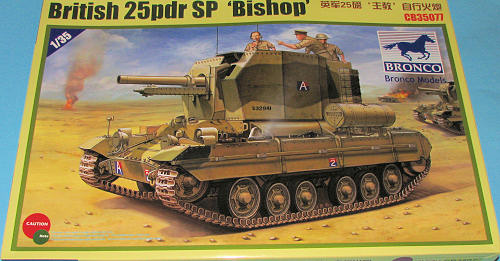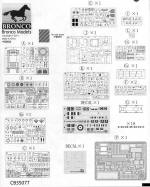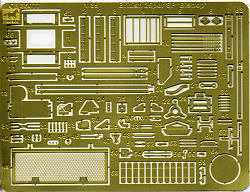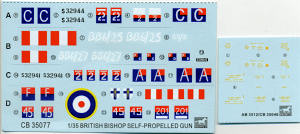
Bronco 1/35 British 25 pdr SP 'Bishop'
| KIT #: | CB35077 |
| PRICE: | $73.00 SRP |
| DECALS: | Four Options |
| REVIEWER: | Scott Van Aken |
| NOTES: | Includes photo etch and individual track links |

| HISTORY |
The Bishop was based on the Valentine II hull, with the turret replaced by a fixed boxy superstructure with large rear doors. Into this superstructure the 25 pounder gun-howitzer was fitted. As a consequence of the gun mounting the resulting vehicle had very high silhouette, a disadvantage in desert warfare. The maximum elevation for the gun was limited to 15 degrees, lowering the range considerably to about 6,400 yards (about half that of the gun on its wheeled carriage), the maximum depression was 5 degrees and traverse 8 degrees. In addition to the main armament the vehicle could carry a Bren light machine gun. By July 1942 80 Bishops had been built, and as the last 20 were being built an order for a further 50 was placed, with an option for a further 200, but the tender was abandoned in favour of the American M7 105 mm SP gun.
The Bishop first saw action during the Second Battle of El Alamein in North Africa and remained in service during the early part of the Italian Campaign. Due to the aforementioned limitations, compounding the Valentine's characteristic slow speed, the Bishop was poorly received almost universally. In order to compensate for insufficient elevation, crews would often build large ramps out of the earth - running the Bishop onto these tilted the whole vehicle back effectively gaining extra elevation for the gun and increasing its maximum range.
It was replaced in service by the M7 Priest (105 mm) and Sexton (25-pounder) when those became available in sufficient numbers, and surviving Bishops were diverted for artillery use.
| THE KIT |
 Here is another well detailed kit from Bronco. The kit includes a nicely done interior complete with driver's station and large transmission. In the back, there is a rear end section with cooling fans and large radiators that can be swiveled to reveal more detail. What is the only thing missing is an engine!
Here is another well detailed kit from Bronco. The kit includes a nicely done interior complete with driver's station and large transmission. In the back, there is a rear end section with cooling fans and large radiators that can be swiveled to reveal more detail. What is the only thing missing is an engine!
This is all from their Valentine tank so those who have built that kit will recognize many of the features. What is new to this kit is the upper body work that includes the 25 pounder gun (a kit also available on its own) and the various shielding that was typical of the Bishop. This shielding is admirably thin as on the real vehicle. A nice and rather comprehensive photo etch sheet is included that covers quite a few of the smaller detail parts like muffler screen, some grab handles and other bits.
The kit suspension and tracks are all nicely detailed. Like many Bronco kits, where there are rivets that would be damaged by mold seams, those rivets are left off and the modeler will need to remove some that are molded onto sprues to replace them. While some my not like this, others applaud it as fine detail like this is often damaged during seam removal.
Inside the gun shield are well detailed radios and many ammunition racks. Bronco includes separate rounds for your use as well as some ammo cases. The Bishop has large doors on the back, unlike many SPGs, and these can be posed open or closed. If closed, then all that interior detail will disappear from view.

 Marking options are for four tanks. The basically tan ones are from Libya in 1942 with the 121st Field Regiment while the overall OD tanks are from the 1943 Sicily campaign with the 6th Armored Division. Decals are well printed and colorful. Not shown is a sheet that is just for the ammunition and crates.
Marking options are for four tanks. The basically tan ones are from Libya in 1942 with the 121st Field Regiment while the overall OD tanks are from the 1943 Sicily campaign with the 6th Armored Division. Decals are well printed and colorful. Not shown is a sheet that is just for the ammunition and crates. | CONCLUSIONS |
| REFERENCES |
http://en.wikipedia.org/wiki/Bishop_%28artillery%29
September 2011
If you would like your product reviewed fairly and fairly quickly, please contact the editor or see other details in the
Back to the Previews Index Page